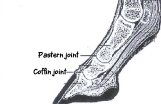|
Navicular
About Navicular The first thing we need to establish is that this is a soundness problem in horses, and not actually a disease. Veterinarians prefer to call it a syndrome. To better understand it, you really need to have some knowledge of the horse’s forelimb anatomy. The navicular bone lies behind the coffin bone and under the pastern bone.
Causes of Navicular There are several known theories to the cause of Naviular. Two important factors are:
There are some factors that contribute to the cause of navicular such as conformation, body weight and horses that are stall-kept or have strong physical demands placed on them. Symptoms of Navicular The symptoms of Navicular are usually a gradual and progressive increase in lameness of the front legs. A tip-toe gait or walk is a common sign, as the horse is trying to walk on the toes due to the heel pain. They may also take longer to stop the stride because they will not place weight on the heel. Some other signs to look for include
After several months of pain, the feet may begin to change shape, becoming more upright and narrow.
Treatment of Navicular Since there are different causes for Navicular in horses, no single treatment works for all cases. The advanced degenerative changes are non-reversible, so the best thing do is manage the condition and focus on alleviating the pain.
The prognosis for a horse with Navicular is usually guarded. After time, all horses with Navicular will need to lessen the strenuousness of their work, but with proper management, a horse with Naviular can remain useful for some time.
Back to Horse Health
|






 It is supported by ligaments above, below and on the side. Cartilage lies between the navicular bone and coffin joint and between the navicular bone and the DDF tendon. The bursa is a small sac filled with a lubricative substance that protects the DDF tendon and navicular bone from abrasion as the tendon slides over the area. The bursa is located between the navicular bone and DDF tendon.
It is supported by ligaments above, below and on the side. Cartilage lies between the navicular bone and coffin joint and between the navicular bone and the DDF tendon. The bursa is a small sac filled with a lubricative substance that protects the DDF tendon and navicular bone from abrasion as the tendon slides over the area. The bursa is located between the navicular bone and DDF tendon.